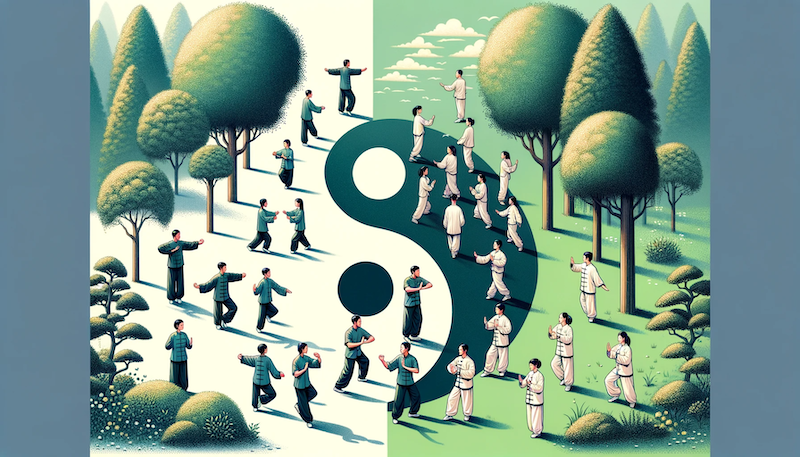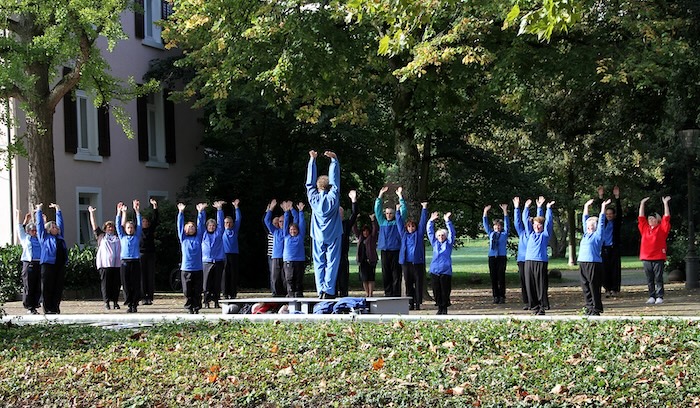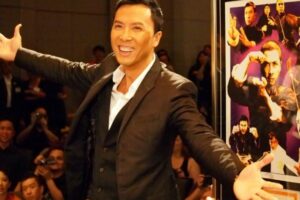
Tai Chi and Qi Gong are both ancient Chinese practices rooted in the philosophy of Traditional Chinese Medicine, focusing on the cultivation of ‘Qi’ (life energy).
Despite their shared origins and objectives, they differ significantly in various aspects. In this article, we share a concise examination of their key differences.
Tai Chi vs Qi Gong: What’s the Difference?
Short Answer: Tai Chi, originating as a martial art, involves complex, flowing movements with an emphasis on self-defense, coordination, and balance, requiring significant time and dedication to master.
Qi Gong, older and rooted in traditional Chinese medicine, consists of simpler, repetitive movements or meditative postures, focusing on health, healing, and energy cultivation.
With this understanding, let’s take a closer look at the 7 differences between Tai Chi and Qi Gong.
1. Historical Background and Evolution (Qi Gong Is Older)
Tai Chi: Developed in the 16th century by Chen Wangting, a retired warrior, Tai Chi (or Tai Chi Chuan) was initially a martial art form.
Over centuries, it evolved, influenced by Taoist and Confucian philosophies, into a practice including self-defense techniques and emphasizing health, meditation, and a harmonious balance between mind and body.
Different styles of Tai Chi, such as Yang, Wu, and Sun, have emerged, each with unique characteristics but all retaining the core principles of fluidity, control, and relaxation.
Qi Gong: Qi Gong’s history dates back over 5,000 years, making it one of the oldest forms of health care in the world. It’s deeply rooted in traditional Chinese medicine, philosophy, and martial arts.
Qi Gong was initially practiced for spiritual growth and longevity, with a strong emphasis on breathing techniques, gentle movements, and meditation.
Over time, it has evolved into various forms, each serving different health and spiritual purposes, and has become an integral part of daily life in Chinese culture, as well as a key component in Chinese medical therapy.
2. Movement Style and Practice (Tai Chi Is More Complex)

Tai Chi: Characterized by a series of flowing, interconnected movements or forms, such as the Yang style, which is known for its gentle, wide-ranging motions, or the Chen style, which includes more explosive movements and a higher degree of physicality.
Each movement in Tai Chi, like ‘Wave Hands Like Clouds’ or ‘Grasp the Sparrow’s Tail,’ has a specific posture and sequence, often named and carrying a symbolic meaning.
The practice is akin to a slow, meditative dance, requiring precision and fluidity.
Qi Gong: Involves simpler, repetitive movements or static postures, which are easier to learn and execute. Examples include ‘Lifting the Sky,’ a movement for stimulating energy flow, or ‘Standing Like a Tree,’ a meditative posture for grounding and centering.
Qi Gong can include active forms, like the ‘Eight Pieces of Brocade’ (Ba Duan Jin), focusing on physical health and flexibility, or passive forms, such as ‘Six Healing Sounds,’ which emphasize internal healing and meditation.
3. Martial Arts vs. Health Focus (Tai Chi Is a Martial Art)
Tai Chi: Originally developed for self-defense, Tai Chi’s movements are deeply rooted in martial arts. For example, forms like ‘Push Hands’ are directly linked to martial applications, teaching students how to sense and redirect an opponent’s energy.
Today, while many practice Tai Chi primarily for its health benefits, such as improved balance and stress reduction, there remains a strong martial arts community that focuses on Tai Chi as a combat technique, emphasizing its origins in Chinese martial traditions.
Qi Gong: Qi Gong’s primary focus is on health and wellness, rather than martial applications. Its practices involve exercises designed to enhance life energy (‘Qi’) for better health, stress management, and increased vitality.
For instance, ‘The Crane Frolics’ from the Five Animal Frolics Qi Gong is a set of movements designed to improve lung capacity and balance, demonstrating Qi Gong’s emphasis on health and internal energy cultivation rather than self-defense or combat skills.
4. Complexity and Learning Curve (Tai Chi Takes Longer)
Tai Chi: Known for its complexity, mastering Tai Chi can be a long-term commitment. Beginners might spend months or even years learning the basic forms.
A typical Tai Chi sequence, such as the popular 24-form Yang style, can take about 6 months to learn at a basic level.
However, truly mastering Tai Chi, with its intricate movements and philosophical depths, often requires years of dedicated practice.
Its demand for coordination, balance, and precise movement makes it a challenging yet rewarding practice for beginners.
Qi Gong: In contrast, Qi Gong is more accessible to beginners due to its simplicity. The basic movements of Qi Gong can often be learned in a matter of weeks.

For instance, a simple Qi Gong routine like the Eight Pieces of Brocade (Ba Duan Jin) can be learned in a few sessions, although deeper mastery and understanding of the energy work involved will take longer.
Qi Gong’s adaptability makes it suitable for people of all ages and physical abilities, including those who may need to practice while seated or have limited mobility.
This accessibility allows practitioners to quickly experience the health benefits of Qi Gong without the steep learning curve of Tai Chi.
5. Philosophical and Spiritual Elements (Qi Gong Is More Spiritual)
Tai Chi: Tai Chi’s movements are deeply intertwined with Taoist and Confucian philosophies, emphasizing concepts like yin and yang, balance, and the flow of Qi.
This integration is evident in the practice’s focus on harmony between the mind, body, and environment.
Tai Chi also incorporates the Taoist principles of naturalness and effortlessness in movements, encouraging a meditative state that aligns with the natural order of the universe.
Qi Gong: Qi Gong’s practices are steeped in both Taoist and Buddhist philosophies, but they place a greater emphasis on spiritual cultivation and internal healing.
Qi Gong exercises often involve meditation, controlled breathing, and visualization techniques aimed at enhancing spiritual awareness and emotional balance.
The practice is seen as a way to connect with and harness the energy of the universe for personal growth and healing, making it a deeply spiritual experience for many practitioners.
6. Health Benefits and Applications (Qi Gong Is Gentler)
Tai Chi: Primarily enhances physical coordination and balance, crucial for fall prevention, especially in older adults. Its complex movements, rooted in martial arts, improve muscular strength and flexibility.
Tai Chi’s emphasis on mental discipline and meditative practices also aids in stress reduction and mental clarity, making it beneficial for cognitive health and emotional well-being.
Qi Gong: Known for its effectiveness in stress relief and internal healing. The practice’s simpler movements facilitate easier energy regulation within the body, promoting relaxation and emotional balance.
Qi Gong’s varied techniques, including breathing exercises and meditations, are particularly beneficial for boosting immunity, improving respiratory function, and enhancing overall well-being, making it suitable for those seeking a gentler, more therapeutic approach to health.
7. Cultural Integration and Global Expansion (Tai Chi Is Widespread)
Tai Chi: Tai Chi has gained significant international popularity and is now practiced in many countries around the world, including the United States, Canada, Australia, the United Kingdom, and various European nations.
It’s often seen in public spaces like parks, as well as in gyms and studios. Tai Chi’s appeal lies in its health benefits and cultural and philosophical richness, making it a practice that resonates across diverse cultures.
Qi Gong: While Qi Gong is a cornerstone of daily life in China and is integrated into its national health system, its international presence is growing, albeit more slowly than Tai Chi.
It’s gaining recognition in Western countries, particularly among those interested in holistic health practices.
Qi Gong is increasingly found in wellness centers, community classes, and some healthcare settings in the United States, Europe, and Australia, where it’s valued for its therapeutic and meditative qualities.
The Bottom Line
In conclusion, Tai Chi and Qi Gong, while sharing a common heritage in Traditional Chinese Medicine, offer distinct paths to wellness, each with its unique historical origins, movement styles, complexity, and focus.
Tai Chi, with its martial arts background, offers a structured approach to body-mind integration, emphasizing coordination, balance, and mental discipline.
Qi Gong, with its deeper roots in spiritual and healing practices, provides a more accessible and varied approach, focusing on internal healing, stress relief, and energy cultivation.
The choice between Tai Chi and Qi Gong should be guided by individual health goals, interests, and physical capabilities.
Both practices contribute to improved physical health and mental well-being and offer a deeper connection with traditional Chinese wisdom and philosophy.




